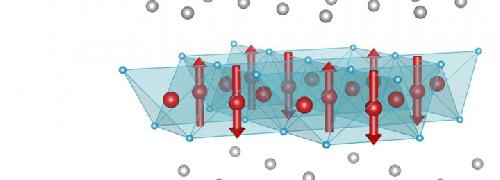New magnetism research brings high-temp superconductivity applications closer
ARGONNE, Ill. - A research team led by the U.S. Department of Energy's (DOE) Argonne National Laboratory has discovered that only half the atoms in some iron-based superconductors are magnetic, providing a conclusive demonstration of the wave-like properties of metallic magnetism in these materials.
The discovery allows for a clearer understanding of the magnetism in some compounds of iron, the iron arsenides, and how it helps induce superconductivity, the resistance-free flow of electrical current through a solid-state material, which occurs at temperatures up to 138 degrees Kelvin, or minus -135 degrees Celsius.
 Magnetic order in (Sr,Na)Fe2As2: The crystal structure contains planes of iron atoms (shown as red spheres). Half the iron sites have a magnetization (shown as red arrows), which points either up or down, but the other half have zero magnetization. This shows that the magnetism results from the constructive and destructive interference of two magnetization waves, a clear sign that the magnetic electrons are itinerant, which means they are not confined to a single site. The same electrons are responsible for the superconductivity at lower temperature. Credit: Osborn et. al
Magnetic order in (Sr,Na)Fe2As2: The crystal structure contains planes of iron atoms (shown as red spheres). Half the iron sites have a magnetization (shown as red arrows), which points either up or down, but the other half have zero magnetization. This shows that the magnetism results from the constructive and destructive interference of two magnetization waves, a clear sign that the magnetic electrons are itinerant, which means they are not confined to a single site. The same electrons are responsible for the superconductivity at lower temperature. Credit: Osborn et. al
"In order to be able to design novel superconducting materials, one must understand what causes superconductivity," said Argonne senior physicist Raymond Osborn, one of the project's lead researchers. "Understanding the origin of magnetism is a first vital step towards obtaining an understanding of what makes these materials superconducting. Given the similarity to other materials, such as the copper-based superconductors, our goal was to improve our understanding of high-temperature superconductivity."
From an applied perspective, such an understanding would allow for the development of magnetic energy-storage systems, fast-charging batteries for electric cars and a highly efficient electrical grid, said Argonne senior physicist Stephan Rosenkranz, the project's other lead researcher.
Superconductors reduce power loss. The use of high-temperature superconducting materials in the electrical grid, for example, would significantly reduce the large amount of electricity that is lost as it travels though the grid, enabling the grid to operate more efficiently.
The researchers were able to show that the magnetism in these materials was produced by mobile electrons that are not bound to a particular iron atom, producing waves of magnetization throughout the sample. They discovered that, in some iron arsenides, two waves interfere to cancel out, producing zero magnetization in some atoms. This quantum interference, which has never been seen before, was revealed by Mössbauer spectroscopy, which is extremely sensitive to the magnetism on each iron site.
Researchers also used high-resolution X-ray diffraction at the Advanced Photon Source (APS) and neutron diffraction at Oak Ridge National Laboratory's Spallation Neutron Source (SNS) to determine the chemical and magnetic structures and to map the electronic phase diagram of the samples used. The APS and SNS are DOE Office of Science User Facilities.
"By combining neutron diffraction and Mössbauer spectroscopy, we were able to establish unambiguously that this novel magnetic ground state has a non-uniform magnetization that can only be produced by itinerant electrons. These same electrons are responsible for the superconductivity," Rosenkranz said.
The research is available in the January 25, 2016 online edition of Nature Physics.
Next, Rosenkranz and Osborn plan to characterize the magnetic excitations, or fluctuations of iron-based superconductors, to determine how they to relate to and possibly cause superconductivity.
source: DOE/Argonne National Laboratory